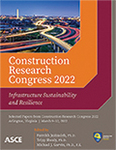Comparison of Different Blue–Green Infrastructure Strategies in Mitigating Urban Heat Island Effects and Improving Thermal Comfort
Publication: Construction Research Congress 2022
ABSTRACT
Urban heat island (UHI) as one of the major consequences of urban development has been extensively studied. Various strategies have been proposed to mitigate the UHI effect. Particularly, the blue–green infrastructure (BGI) using vegetation and water bodies for environmental cooling have received growing attention. However, there are limited publications on the microclimatic effects in the vicinity of river corridors in urban areas and strategies to improve thermal comfort. Using a restored urban stream as a case, this research aims to evaluate the effectiveness of different strategies on thermal performance, including the expansion of water coverage, addition of vegetation, and conversion of the original concrete riverbed into porous substrate. A micro-scale computational fluid dynamic (CFD) model was used to simulate the diurnal profiles of the river corridors. Using the Universal Thermal Climate Index (UTCI) as an indicator, the study found that street trees are associated with the average lowest values of UTCI during the daytime, while using porous substrate can also reduce UTCI with a maximum UTCI reduction of 3.46°C. However, during the hottest hours of the day, porous substrate even causes an increase in UTCI by reflecting more short-wave radiation. This finding also provides the general procedure of evaluating the relationship between BGI optimization strategies and outdoor thermal comfort.
Get full access to this article
View all available purchase options and get full access to this chapter.
REFERENCES
Ali-Toudert, F., and H. Mayer. (2006). “Numerical study on the effects of aspect ratio and orientation of an urban street canyon on outdoor thermal comfort in hot and dry climate.” Building and Environment 41(2): 94–108.
Ali-Toudert, F., and H. Mayer. (2007). “Effects of asymmetry, galleries, overhanging façades and vegetation on thermal comfort in urban street canyons.” Solar Energy 81(6): 742–754.
Berardi, U. (2016). “The outdoor microclimate benefits and energy saving resulting from green roofs retrofits.” Energy and Buildings 121: 217–229.
Blazejczyk, K., Y. Epstein, G. Jendritzky, H. Staiger, and B. Tinz. (2012). “Comparison of UTCI to selected thermal indices.” Int J Biometeorol 56(3): 515–535.
Brode, P., D. Fiala, K. Blazejczyk, I. Holmer, G. Jendritzky, B. Kampmann, B. Tinz, and G. Havenith. (2012). “Deriving the operational procedure for the Universal Thermal Climate Index (UTCI).” Int J Biometeorol 56(3): 481–494.
Bruse, M., and H. Fleer. (1998). “Simulating surface–plant–air interactions inside urban environments with a three dimensional numerical model.” Environmental modelling & software 13(3-4): 373–384.
Chen, H., R. Ooka, H. Huang, and T. Tsuchiya. (2009). “Study on mitigation measures for outdoor thermal environment on present urban blocks in Tokyo using coupled simulation.” Building and Environment 44(11): 2290–2299.
Du, H., Y. Cai, F. Zhou, H. Jiang, W. Jiang, and Y. Xu. (2019). “Urban blue-green space planning based on thermal environment simulation: A case study of Shanghai, China.” Ecological Indicators 106.
Geletic, J., M. Lehnert, S. Savic, and D. Milosevic. (2018). “Modelled spatiotemporal variability of outdoor thermal comfort in local climate zones of the city of Brno, Czech Republic.” Sci Total Environ 624: 385–395.
Ghofrani, Z., V. Sposito, and R. Faggian. (2017). “A comprehensive review of blue-green infrastructure concepts.” International Journal of Environment and Sustainability 6(1).
Gunawardena, K. R., M. J. Wells, and T. Kershaw. (2017). “Utilising green and bluespace to mitigate urban heat island intensity.” Sci Total Environ 584-585: 1040–1055.
Huttner, S. (2012). “Further development and application of the 3D microclimate simulation ENVI-met.” Mainz: Johannes Gutenberg-Universitat in Mainz 147.
Lamond, J., and G. Everett. (2019). “Sustainable Blue-Green Infrastructure: A social practice approach to understanding community preferences and stewardship.” Landscape and Urban Planning 191.
Makaremi, N., E. Salleh, M. Z. Jaafar, and A. GhaffarianHoseini. (2012). “Thermal comfort conditions of shaded outdoor spaces in hot and humid climate of Malaysia.” Building and Environment 48: 7–14.
Sailor, D. J. (2008). “A green roof model for building energy simulation programs.” Energy and Buildings 40(8): 1466–1478.
Shi, D., J. Song, J. Huang, C. Zhuang, R. Guo, and Y. Gao. (2020). “Synergistic cooling effects (SCEs) of urban green-blue spaces on local thermal environment: A case study in Chongqing, China.” Sustainable Cities and Society 55.
Standard, I. and B. ISO. (1998). Ergonomics of the thermal environment—instruments for measuring physical quantities.
Taleghani, M., D. Sailor, and G. A. Ban-Weiss. (2016). “Micrometeorological simulations to predict the impacts of heat mitigation strategies on pedestrian thermal comfort in a Los Angeles neighborhood.” Environmental Research Letters 11(2).
Theeuwes, N. E., A. Solcerová, and G. J. Steeneveld. (2013). “Modeling the influence of open water surfaces on the summertime temperature and thermal comfort in the city.” Journal of Geophysical Research: Atmospheres 118(16): 8881–8896.
Wanphen, S., and K. Nagano. (2009). “Experimental study of the performance of porous materials to moderate the roof surface temperature by its evaporative cooling effect.” Building and Environment 44(2): 338–351.
Watkins, R., J. Palmer, and M. Kolokotroni. (2007). “Increased temperature and intensification of the urban heat island: Implications for human comfort and urban design.” Built Environment 33(1): 85–96.
Information & Authors
Information
Published In
History
Published online: Mar 7, 2022
Authors
Metrics & Citations
Metrics
Citations
Download citation
If you have the appropriate software installed, you can download article citation data to the citation manager of your choice. Simply select your manager software from the list below and click Download.
